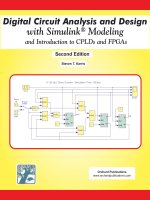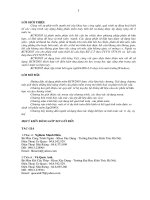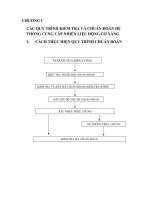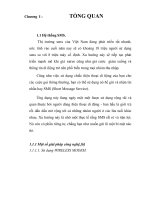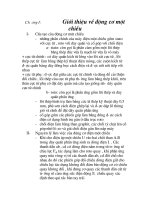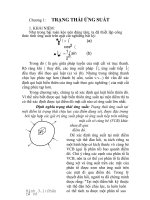Digital Circuit Design-Lecture 1 pps
Bạn đang xem bản rút gọn của tài liệu. Xem và tải ngay bản đầy đủ của tài liệu tại đây (725.73 KB, 17 trang )
ECE 561 - Lecture 1
1
ECE 561
Digital Circuit Design
Department of Electrical and
Computer Engineering
The Ohio State University
ECE 561 - Lecture 1 2
Today
The Course
Syllabus
Intro
ECE 561 - Lecture 1 3
Course Philosophy and Objective
Familiarize students with digital design
practice as well as principles
Learn a way to use actual chips for
designing practical digital circuits
Learn modern design technologies with
Xilinx software and programmable chips
See the role HDLs have played in design
methodology
ECE 561 - Lecture 1 4
Modern Digital Design
Real logic designs are too large to solve
by straight theoretical approach
Today’s methodology
Requires use of subdivision of system into
Logic Building Blocks. Far above the gate
level of AND/OR gates.
Use of CAD
Use of PLDs and FPGA – state of the art
programmable chips.
ECE 561 - Lecture 1 5
Course Topics
Review of combination and sequential
logic
Analysis of sequential circuits
Logic Building Blocks and applications
Counters, shift registers, comparators
Review of traditional approaches to
sequential design
ECE 561 - Lecture 1 6
Course Topics (2)
Structured Sequential Design
Based on Logical Building Blocks
Complex System = Sum of smaller systems
Organize functions, inputs, outputs from word
description of problem
Art – choose LBBs and organize
Science – function and timing
Design Technology
Using modern CAD
Use programmable chips – PLDs and FPGAs
Use of HDLs – VHDL, Verilog, System C
ECE 561 - Lecture 1 7
Combination Logic Design
In today’s world digital circuits, both
combinational and sequential, have
millions of gates and several hundred, if
not thousands, of inputs and outputs.
How do you handle this?
Challenges the scope of human
comprehension.
ECE 561 - Lecture 1 8
Documentation
“Good documentation is essential for
correct design” (from text)
Design specification must be accurate,
complete and understandable
The starting place is a good specification
of the circuit or system.
ECE 561 - Lecture 1 9
The Specificaiton
Describes exactly what the circuit of
system is supposed to do.
All inputs and outputs are accurately
specified
The internal function performed is fully
specified
Timing is clear and precise
ECE 561 - Lecture 1 10
Other aspects of documention
Block Diagram
Schematic Diagram
Timing Diagram
Structured Logic Description
HDL description both documents and allows
for simulation and synthesis of the design
Circuit Description
ECE 561 - Lecture 1 11
Block Diagrams
Shows inputs and outputs and functional
modules
ECE 561 - Lecture 1 12
Gate Symbols
ECE 561 - Lecture 1 13
Active high and Active low
ECE 561 - Lecture 1 14
Circuit Timing
“Timing is everything”
In Comedy
In Investing
In digital design
When the inputs change the output of
the gate will respond to that change.
The output will change (if it does) after
the internal circuitry of the gate settles to
the new output state.
ECE 561 - Lecture 1 15
Circuit Timing (2)
Glitches on the output occur when the
inputs do not arrive simultaneously.
It is almost impossible to design a
combinational logic circuit that is 100%
glitch free. It can be design such that
the glitches that do occur are
insignificant.
ECE 561 - Lecture 1 16
Timing Analysis Tools
Circuit timing waveforms
ECE 561 - Lecture 1 17
Assignment
Read 6.1-2, 7.1-2
